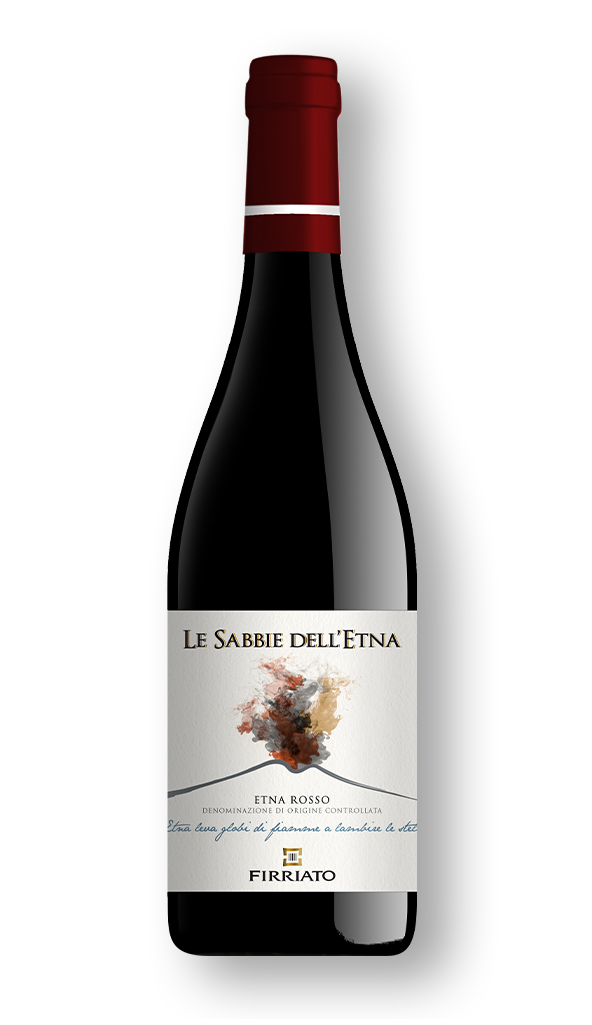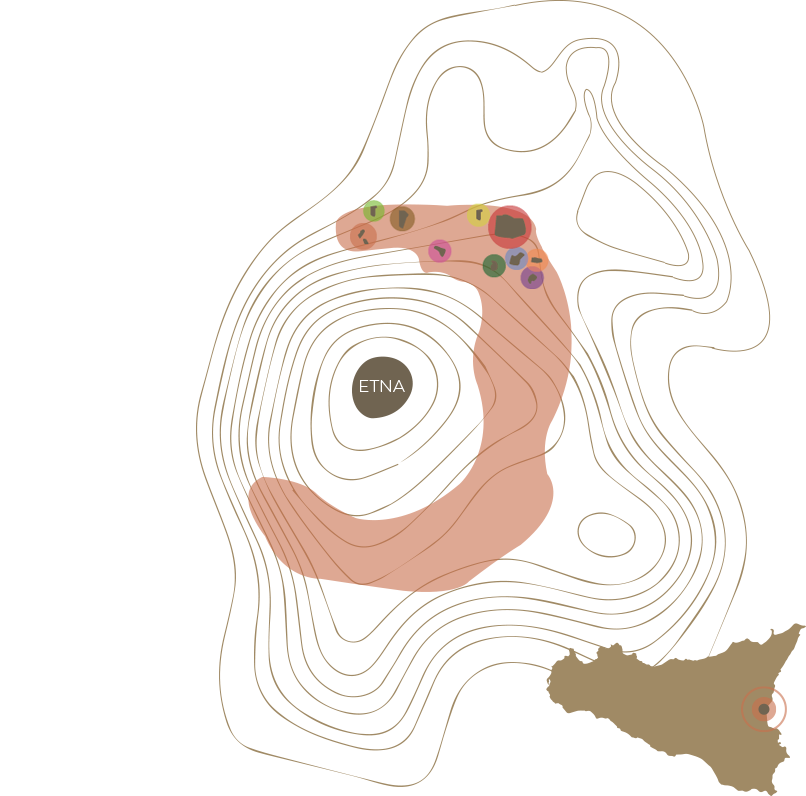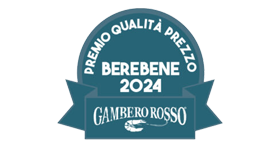
Le Sabbie dell’Etna Rosso is, together with its white variant, the progenitor of Firriato’s decades-long production on Etna. The wines of the Tenuta di Cavanera Etnea are elite by birth and dedicated to exclusivity. Labels designed and dedicated to the most demanding wine lovers. Le Sabbie dell’Etna Rosso reveals itself in the glass with a delicious and complex bouquet with notes of cinnamon, black pepper, blackcurrant and cherry in alcohol. Only the extraordinary terroir of the northern side of Etna, on the slopes of the largest active volcano in Europe, could generate this wine with great personality.

Le Sabbie dell’Etna Rosso is, together with its white variant, the progenitor of Firriato’s decades-long production on Etna. The wines of the Tenuta di Cavanera Etnea are elite by birth and dedicated to exclusivity. Labels designed and dedicated to the most demanding wine lovers. Le Sabbie dell’Etna Rosso reveals itself in the glass with a delicious and complex bouquet with notes of cinnamon, black pepper, blackcurrant and cherry in alcohol. Only the extraordinary terroir of the northern side of Etna, on the slopes of the largest active volcano in Europe, could generate this wine with great personality.
The microbiological and microchemical nature of lava flows differs greatly in its concentration of elements, not only in correspondence with a specific time band during which the magmatic activity took place, but also functionally in a specific area of the volcano affected by the eruptive phenomena. From this arises a very varied pedological picture and consequently a very varied supply of microelements, which both in viticulture and in oenology, ensures a multiple reading of the same Terroir to which it belongs. This means that it is possible that the same vine can give rise to completely different wines depending on the areas, better called and known as, “contrade” where the vineyards are located. The company’s vineyards are spread over 12 Contrade, with very different soil and climate characteristics that allow it to support a varied and always excellent production.

Castiglione di Sicilia - Randazzo
590-720 mt s.l.m.
North/North East
The 2020 harvest on the north-eastern side of the volcano was regular, thanks to a climatic trend which recorded temperatures below the seasonal average (the only exception being the first ten days of August) and abundant rainfall which slightly postponed the maturation phase and collection. The temperature variations - particularly accentuated, especially in the spring period - then determined a particularly high quality of the grapes, guaranteeing the wines intense and complex aromatic profiles. The Nerello Mascalese grapes, harvested in the first week of October, recorded a slower maturation with a good accumulation of aromatic substances.
The 2019 vintage is generally affected by the colder and rainier climate trend compared to the averages of recent years. Temperatures were below the seasonal average during the flowering period and favorable climatic conditions were also recorded during ripening. The vegetative development of the plants was optimal, with perfectly functioning foliage and a reduction in the average weight of the bunch which favored an increase in the average quality. During the ripening process, an increase in the level of sugars and the component of aroma precursors in the grapes was recorded thanks to the strong temperature variations between day and night. This evidence attributes to the vintage characteristics of excellent balance between the olfactory (aromatic) and gustatory components (alcohol/freshness ratio). The red Nerello Mascalese grapes for red wines recorded a slower maturation and enjoyed significant temperature variations between day and night, also favoring the accumulation of polyphenolic substances in this case. Harvesting operations began with an average delay of 8-10 days compared to the previous year. The wine has a bright red colour, spicy and mineral notes, balanced, harmonious and with soft tannins.
The climatic trend of the first months of 2018 was characterized by a mild winter and a spring with average temperatures. The summer, on the contrary, was characterized by rain and bad weather. Precipitation was more abundant and particularly concentrated in June, the wettest month of the last thirty years, according to regional averages. Despite the early summer rains, the Etna vineyards benefited from favorable climatic conditions, preserving the grapes in the most delicate stages of fruit development and maturation.
The month of September recorded a slight increase in humidity and minimum temperatures compared to last year, but without ever causing particular phytosanitary problems. Overall, vegetative-productive development was regular, with the plants regaining better vigor, restoring production potentials that had lowered the previous year due to significant thermal and water stress. The harvest of the red grape varieties began in the third ten days of October. A red with a brighter color and spicy notes, thanks to the lower temperatures, is expected to create an aromatic complement of great finesse.
The 2017 wine year was characterized by an averagely cool autumn and winter and a practically almost dry spring. Since February, with the exception of some precipitation in April, it has practically never rained. The summer, starting from the month of June, was very hot, with high thermal values, which reached their peaks between the last days of July and the first ten days of August with maximum temperatures of up to 45-46°C. The harvest was on average ten days earlier than last year. This allowed us to preserve the acidity and freshness of the grapes. The vine slowed down its functions and, when heavy rains arrived in mid-September, it completed its maturation. After the rains the weather turned nice and the harvest concluded perfectly, recording high levels of quality in the grapes. We expect well-concentrated, fragrant and fruity reds.
In quantitative terms we are in line with the 2015 vintage but on a qualitative level the wines obtained are very aromatic whites with excellent acidity. the Nerello Mascalese revealed bright colours, without excess alcohol; the classic method bases have a higher malic acid content than the 2015 vintage. Harvest period for Nerello Mascalese and Nerello Cappuccio: 2nd half of October.
The winter was harsh with abundant rainfall. The spring was also very rainy with temperatures below the seasonal average, this led to later budding. The vegetative growth was excellent, the high temperatures of May and June took advantage of the splendid flowering followed by excellent fruit set. The hailstorm that hit on June 9th fortunately caused little damage to the vegetation. In terms of health, the vintage was excellent, with healthy grapes and no parasitic attacks. The abundant rains in August and the drop in temperatures made us think of a difficult harvest, but instead they created a reserve of water that allowed us to reach September with good vitality in the plants. Overall it was a very interesting vintage with a very high level of quality.
The climatic trend was decisive for the quality of the grapes produced, after the spring and early summer rains, the temperatures gradually approached the seasonal averages, but without peaks of heat. Finally we have returned to a more "Etna style" vintage. In the month of September the rains arrived but despite the concern that made us think of a difficult vintage, the month of October, the fateful month of the harvest, was merciful with sunny days and no rain, making it possible to bring grapes from the point of view to the cellar. from an excellent health point of view with leaf surface/production ratios in a state of absolute balance (approximately 1m2 of leaf surface per kg of grapes).
The vintage appears to be fruitful, both in quantity and above all in quality, "wines with an interesting profile" were obtained. Due to the climate, the harvest lasted until the last week of September. The 2013 vintage allowed a slower harvest and therefore gradual maturation: the harvest was delayed by two weeks. Harvest date: October 20th.
The progress of the vegetative cycle of the vine, during the flowering and fruit set periods, followed a normal course. There were no anomalies during the veraison and ripening phases. The harvest, for the early white varieties, began earlier than the previous campaign. Lucifer, Charon and the other African anticyclones this summer were a godsend for the harvest, "an exceptional year from a quality point of view". This year the heat anticipated its start, the high temperatures also had the merit of improving the quality of the wine we will drink: the heat brings a dehydration effect to the grapes, which causes the water to evaporate, concentrating the acids and sugars, giving life to fragrant wines. Collection date: October 15th.
The climatic conditions recorded during the course of the year were quite stable: the winter was characterized by average temperatures and lower rainfall compared to previous years; the rains, however, were abundant in the spring months, preparing the vineyard in the best possible way. The harvest was carried out manually between the second and third ten days of October and recorded a 15% drop in production due to the small size of the bunch but, from a quality point of view, the vintage was excellent. The fermentation, in thermo-controlled stainless steel tanks, lasted 14 days; the wine was stored in oak barriques for approximately 6 months and continued refinement in the bottle for 2 months.
The climate of the 2010 vintage was characterized by a winter with normal temperatures and little rainfall and a mild spring with little rain. The drought of the summer season risked compromising the well-known perfection of the fruit but the intervention of favorable rainfall at the end of September kept the quality of the grapes high. The pre-harvest period was characterized by cool temperatures, oscillating between 20 and 22°C, and abundant rain, which delayed the start of the harvest by a few days due to the slow ripening of the grapes. The harvesting operations of the Nerello Mascalese and Nerello Cappuccio varieties began at the beginning of October and were carried out by hand by the farmers of Etna
The budding of the plants was delayed compared to previous years due to the favorable climate trend in 2009. The autumn season was characterized by a fairly harsh climate and abundant rainfall, which was also frequent in spring. In this first phase, the growth of the vines slowed down considerably, proceeding regularly in the very hot and humid summer months. The vegetative cycle was constant and allowed for excellent ripening of the fruits, which were harvested manually.
It was a fairly good year, which began with a climate favorable to the budding of the plant, earlier than annual estimates, and ended with some slowdown in spring due to heavy rainfall, which compromised the growth of the plant while preserving its health. The summer months provided a warm and humid climate, allowing the grapes to ripen perfectly.
It was not an excellent year due to the unstable climatic conditions, with little rainfall in the winter months and abundant rainfall in the spring. Production was greatly affected in quantitative terms, with a drop of 35% compared to the previous year. Another determining factor in the lack of production of this harvest, which began on 15 October, was the attack of downy mildew during the fruit setting phase. However, the quality of the grapes, and of the wine produced subsequently, was excellent.
The 2020 harvest on the north-eastern side of the volcano was regular, thanks to a climatic trend which recorded temperatures below the seasonal average (the only exception being the first ten days of August) and abundant rainfall which slightly postponed the maturation phase and collection. The temperature variations - particularly accentuated, especially in the spring period - then determined a particularly high quality of the grapes, guaranteeing the wines intense and complex aromatic profiles. The Nerello Mascalese grapes, harvested in the first week of October, recorded a slower maturation with a good accumulation of aromatic substances.
The 2019 vintage is generally affected by the colder and rainier climate trend compared to the averages of recent years. Temperatures were below the seasonal average during the flowering period and favorable climatic conditions were also recorded during ripening. The vegetative development of the plants was optimal, with perfectly functioning foliage and a reduction in the average weight of the bunch which favored an increase in the average quality. During the ripening process, an increase in the level of sugars and the component of aroma precursors in the grapes was recorded thanks to the strong temperature variations between day and night. This evidence attributes to the vintage characteristics of excellent balance between the olfactory (aromatic) and gustatory components (alcohol/freshness ratio). The red Nerello Mascalese grapes for red wines recorded a slower maturation and enjoyed significant temperature variations between day and night, also favoring the accumulation of polyphenolic substances in this case. Harvesting operations began with an average delay of 8-10 days compared to the previous year. The wine has a bright red colour, spicy and mineral notes, balanced, harmonious and with soft tannins.
The climatic trend of the first months of 2018 was characterized by a mild winter and a spring with average temperatures. The summer, on the contrary, was characterized by rain and bad weather. Precipitation was more abundant and particularly concentrated in June, the wettest month of the last thirty years, according to regional averages. Despite the early summer rains, the Etna vineyards benefited from favorable climatic conditions, preserving the grapes in the most delicate stages of fruit development and maturation.
The month of September recorded a slight increase in humidity and minimum temperatures compared to last year, but without ever causing particular phytosanitary problems. Overall, vegetative-productive development was regular, with the plants regaining better vigor, restoring production potentials that had lowered the previous year due to significant thermal and water stress. The harvest of the red grape varieties began in the third ten days of October. A red with a brighter color and spicy notes, thanks to the lower temperatures, is expected to create an aromatic complement of great finesse.
The 2017 wine year was characterized by an averagely cool autumn and winter and a practically almost dry spring. Since February, with the exception of some precipitation in April, it has practically never rained. The summer, starting from the month of June, was very hot, with high thermal values, which reached their peaks between the last days of July and the first ten days of August with maximum temperatures of up to 45-46°C. The harvest was on average ten days earlier than last year. This allowed us to preserve the acidity and freshness of the grapes. The vine slowed down its functions and, when heavy rains arrived in mid-September, it completed its maturation. After the rains the weather turned nice and the harvest concluded perfectly, recording high levels of quality in the grapes. We expect well-concentrated, fragrant and fruity reds.
In quantitative terms we are in line with the 2015 vintage but on a qualitative level the wines obtained are very aromatic whites with excellent acidity. the Nerello Mascalese revealed bright colours, without excess alcohol; the classic method bases have a higher malic acid content than the 2015 vintage. Harvest period for Nerello Mascalese and Nerello Cappuccio: 2nd half of October.
The winter was harsh with abundant rainfall. The spring was also very rainy with temperatures below the seasonal average, this led to later budding. The vegetative growth was excellent, the high temperatures of May and June took advantage of the splendid flowering followed by excellent fruit set. The hailstorm that hit on June 9th fortunately caused little damage to the vegetation. In terms of health, the vintage was excellent, with healthy grapes and no parasitic attacks. The abundant rains in August and the drop in temperatures made us think of a difficult harvest, but instead they created a reserve of water that allowed us to reach September with good vitality in the plants. Overall it was a very interesting vintage with a very high level of quality.
The climatic trend was decisive for the quality of the grapes produced, after the spring and early summer rains, the temperatures gradually approached the seasonal averages, but without peaks of heat. Finally we have returned to a more "Etna style" vintage. In the month of September the rains arrived but despite the concern that made us think of a difficult vintage, the month of October, the fateful month of the harvest, was merciful with sunny days and no rain, making it possible to bring grapes from the point of view to the cellar. from an excellent health point of view with leaf surface/production ratios in a state of absolute balance (approximately 1m2 of leaf surface per kg of grapes).
The vintage appears to be fruitful, both in quantity and above all in quality, "wines with an interesting profile" were obtained. Due to the climate, the harvest lasted until the last week of September. The 2013 vintage allowed a slower harvest and therefore gradual maturation: the harvest was delayed by two weeks. Harvest date: October 20th.
The progress of the vegetative cycle of the vine, during the flowering and fruit set periods, followed a normal course. There were no anomalies during the veraison and ripening phases. The harvest, for the early white varieties, began earlier than the previous campaign. Lucifer, Charon and the other African anticyclones this summer were a godsend for the harvest, "an exceptional year from a quality point of view". This year the heat anticipated its start, the high temperatures also had the merit of improving the quality of the wine we will drink: the heat brings a dehydration effect to the grapes, which causes the water to evaporate, concentrating the acids and sugars, giving life to fragrant wines. Collection date: October 15th.
The climatic conditions recorded during the course of the year were quite stable: the winter was characterized by average temperatures and lower rainfall compared to previous years; the rains, however, were abundant in the spring months, preparing the vineyard in the best possible way. The harvest was carried out manually between the second and third ten days of October and recorded a 15% drop in production due to the small size of the bunch but, from a quality point of view, the vintage was excellent. The fermentation, in thermo-controlled stainless steel tanks, lasted 14 days; the wine was stored in oak barriques for approximately 6 months and continued refinement in the bottle for 2 months.
The climate of the 2010 vintage was characterized by a winter with normal temperatures and little rainfall and a mild spring with little rain. The drought of the summer season risked compromising the well-known perfection of the fruit but the intervention of favorable rainfall at the end of September kept the quality of the grapes high. The pre-harvest period was characterized by cool temperatures, oscillating between 20 and 22°C, and abundant rain, which delayed the start of the harvest by a few days due to the slow ripening of the grapes. The harvesting operations of the Nerello Mascalese and Nerello Cappuccio varieties began at the beginning of October and were carried out by hand by the farmers of Etna
The budding of the plants was delayed compared to previous years due to the favorable climate trend in 2009. The autumn season was characterized by a fairly harsh climate and abundant rainfall, which was also frequent in spring. In this first phase, the growth of the vines slowed down considerably, proceeding regularly in the very hot and humid summer months. The vegetative cycle was constant and allowed for excellent ripening of the fruits, which were harvested manually.
It was a fairly good year, which began with a climate favorable to the budding of the plant, earlier than annual estimates, and ended with some slowdown in spring due to heavy rainfall, which compromised the growth of the plant while preserving its health. The summer months provided a warm and humid climate, allowing the grapes to ripen perfectly.
It was not an excellent year due to the unstable climatic conditions, with little rainfall in the winter months and abundant rainfall in the spring. Production was greatly affected in quantitative terms, with a drop of 35% compared to the previous year. Another determining factor in the lack of production of this harvest, which began on 15 October, was the attack of downy mildew during the fruit setting phase. However, the quality of the grapes, and of the wine produced subsequently, was excellent.
The harvest, carried out manually in boxes, is carried out during the third ten days of October. The bunches are first subjected to a selection table and taken to the cellar for destemming, exploiting the gravitational force by falling. The vinification is carried out in stainless steel tanks at a controlled temperature. Subsequently the wine is aged in steel for a period of approximately 6 months, before being bottled.

Brilliant ruby with lively purple hues.

It offers typically mineral notes, mature and elegant, alternating intense and well-defined aromas of blackcurrant, blueberries, plum jam, black cherry, liquorice, pepper and dried violet.

Well balanced, harmonious, it proceeds with energy and liveliness, rich and refined, endowed with sweet tannins and notable lineage; to underline the long aromatic persistence and the satisfying and “juicy” finish.


93 pt

93 pt

93 pt


Ogni bottiglia di Signum Aetnae è conservata all’interno di un sofisticato cofanetto in legno serigrafato, uno scrigno che conferisce un tocco di lusso e raffinatezza al pezzo da collezione. Il cofanetto in legno è realizzato con maestria artigianale e rappresenta un elemento distintivo del packaging. La sua superficie è decorata con un motivo serigrafato di alta qualità che richiama l’identità del vino Signum Aetnae e dell’azienda Firriato.
All’interno del cofanetto, la bottiglia di Signum Aetnae è avvolta con cura in una delicata carta velina, che porta il logo del marchio e un sigillo di autenticità. Questo strato di carta protegge la bottiglia durante il trasporto e contribuisce a creare un’esperienza di apertura memorabile.
All’interno della confezione è presente un pieghevole informativo. Il pieghevole contiene dettagliate istruzioni sull’NFT (Non-Fungible Token) associato al vino Signum Aetnae. Spiega come accedere e godere di contenuti digitali esclusivi tramite l’uso dell’NFT, offrendo un’esperienza unica e coinvolgente per gli appassionati del vino.
All’interno del cofanetto, la bottiglia di Signum Aetnae è avvolta con cura in una delicata carta velina, che porta il logo del marchio e un sigillo di autenticità. Questo strato di carta protegge la bottiglia durante il trasporto e contribuisce a creare un’esperienza di apertura memorabile.
All’interno della confezione è presente un pieghevole informativo. Il pieghevole contiene dettagliate istruzioni sull’NFT (Non-Fungible Token) associato al vino Signum Aetnae. Spiega come accedere e godere di contenuti digitali esclusivi tramite l’uso dell’NFT, offrendo un’esperienza unica e coinvolgente per gli appassionati del vino.
All’interno del cofanetto, la bottiglia di Signum Aetnae è avvolta con cura in una delicata carta velina, che porta il logo del marchio e un sigillo di autenticità. Questo strato di carta protegge la bottiglia durante il trasporto e contribuisce a creare un’esperienza di apertura memorabile.
All’interno della confezione è presente un pieghevole informativo. Il pieghevole contiene dettagliate istruzioni sull’NFT (Non-Fungible Token) associato al vino Signum Aetnae. Spiega come accedere e godere di contenuti digitali esclusivi tramite l’uso dell’NFT, offrendo un’esperienza unica e coinvolgente per gli appassionati del vino.
Ogni bottiglia di Signum Aetnae è accompagnata da un sofisticato cofanetto in legno serigrafato, che aggiunge un tocco di lusso e raffinatezza.
Il cofanetto in legno è realizzato con maestria artigianale e rappresenta un elemento distintivo del packaging. La sua superficie è decorata con un motivo serigrafato di alta qualità che richiama l’identità del vino Signum Aetnae e dell’azienda Firriato.